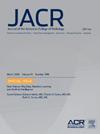Visual Emphysema as a Category Modifier in Lung-RADS Using a Secondary Analysis of National Lung Screening Trial
IF 4
3区 医学
Q1 RADIOLOGY, NUCLEAR MEDICINE & MEDICAL IMAGING
引用次数: 0
Abstract
Objective
The Lung CT Reporting and Data System (Lung-RADS) does not consider emphysema, a lung cancer risk factor detectable on CT, when assessing nodule risk. This study aimed to evaluate the impact of incorporating emphysema into Lung-RADS on lung cancer diagnosis.
Methods
In this secondary analysis of the National Lung Screening Trial data, CT arm participants with noncalcified nodules were assigned to Lung-RADS categories, and their emphysema severity was visually dichotomized. Lung cancer rates within each Lung-RADS category were compared based on emphysema severity. A modified Lung-RADS, reclassifying nodules with significant emphysema into a higher category, was evaluated against standard Lung-RADS.
Results
A study of 9,444 participants (782 [8.3%] with lung cancer) revealed difference in lung cancer rates across Lung-RADS categories based on visual emphysema severity: category 2 (2.6% versus 4.9%; P = .007), 3 (4.9% versus 9.0%; P < .001), 4A (9.2% versus 15.5%; P = .01), 4B (16.1% versus 24.1%; P = .12), and 4X (25.3% versus 33.2%; P = .008) without or with significant emphysema. Compared with standard Lung-RADS, modified Lung-RADS demonstrated a comparable area under the curve (0.73 versus 0.74, P = .009), increased sensitivity (61.3% versus 67.6%, P < .001), decreased specificity (77.2% versus 71.4%, P < .001), and improved goodness of fit (P = .008) for predicting lung cancer.
Discussion
Lung cancer rates differ by emphysema severity within Lung-RADS categories. Using the visual emphysema severity as a category modifier in Lung-RADS increased sensitivity while achieving comparable area under the curve for lung cancer.
视肺气肿作为肺- rads的分类修饰:国家肺筛查试验的二次分析。
目的:肺CT报告和数据系统(Lung- rads)在评估结节风险时未考虑CT可检测到的肺癌危险因素肺气肿。本研究旨在评估肺气肿纳入lung - rads对肺癌诊断的影响。方法:在对国家肺筛查试验数据的二次分析中,CT组中有非钙化结节的参与者被分配到Lung- rads类别,他们的肺气肿严重程度被视觉上二分类。每个Lung- rads类别的肺癌发病率根据肺气肿严重程度进行比较。改进的Lung-RADS,将明显肺气肿结节重新分类到更高的类别,并与标准Lung-RADS进行评估。结果:一项9444名参与者(782例[8.3%]肺癌患者)的研究显示,基于视觉肺气肿严重程度,肺癌发病率在lung - rads类别之间存在差异:2类(2.6% vs. 4.9%;P = 0.007), 3 (4.9% vs. 9.0%;P < 0.001), 4A (9.2% vs. 15.5%;P = 0.01), 4B (16.1% vs. 24.1%;P = 0.12)和4X (25.3% vs. 33.2%;P = 0.008),没有或有明显的肺气肿。与标准lung - rads相比,改进的lung - rads在预测肺癌方面显示出相当的曲线下面积(AUC) (0.73 vs. 0.74, P = 0.009),增加的敏感性(61.3% vs. 67.6%, P < 0.001),降低的特异性(77.2% vs. 71.4%, P < 0.001)和改善的拟合优度(P = 0.008)。讨论:肺癌发病率因肺- rads分类中肺气肿严重程度的不同而不同。使用视觉肺气肿严重程度作为肺- rads的分类调节剂增加了敏感性,同时获得了与肺癌相当的AUC。
本文章由计算机程序翻译,如有差异,请以英文原文为准。
求助全文
约1分钟内获得全文
求助全文
来源期刊

Journal of the American College of Radiology
RADIOLOGY, NUCLEAR MEDICINE & MEDICAL IMAGING-
CiteScore
6.30
自引率
8.90%
发文量
312
审稿时长
34 days
期刊介绍:
The official journal of the American College of Radiology, JACR informs its readers of timely, pertinent, and important topics affecting the practice of diagnostic radiologists, interventional radiologists, medical physicists, and radiation oncologists. In so doing, JACR improves their practices and helps optimize their role in the health care system. By providing a forum for informative, well-written articles on health policy, clinical practice, practice management, data science, and education, JACR engages readers in a dialogue that ultimately benefits patient care.
 求助内容:
求助内容: 应助结果提醒方式:
应助结果提醒方式:


